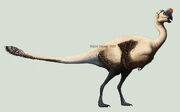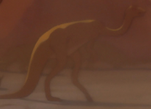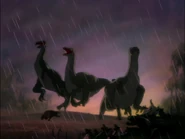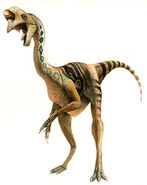| Oviraptor Temporal range: Late Cretaceous | |
|---|---|

| |
| An artist's illustration of Oviraptor philoceratops | |
| Scientific classification | |
| Kingdom: | Animalia |
| Phylum: | Chordata |
| Class: | Sauropsida |
| clade: | Dinosauria |
| Superorder: | Theropoda |
| Genus: | †Oviraptor Osborn et al., 1924 |
| Species: | O. philoceratops |
| Binomial name | |
| Oviraptor philoceratops Osborn et al.,1924 | |
Oviraptor (Greek for "egg thief") is a extinct genus of small, feathered, theropod which lived during the Cretaceous. It was once thought to be an egg-eater, since its remains have been excavated near dinosaur nests. These were later found to be the nest of Oviraptor itself, one specimen even showed a mother which had perished while guarding its nest, probably due to a sandstorm or other natural disaster. Oviraptor had a large beak, once thought to be an egg-breaker; it was more used to catch lizards and other small creatures. Male Oviraptors had flamboyant crests on their heads, possibly used for sexual display.
General Description[]

The first specimen of Oviraptor was discovered by the American Museum of Natural History expedition to Asia in 1923. It was found in the Gobi Desert of Mongolia. This is the same place Protoceratops was found. The specimen was an almost complete skull along with parts of the hands and neck vertebrae. It was found lying next to a nest of eggs that may have belonged to Protoceratops. Henry Fairfield Osborn thought the animal may have died while eating the eggs in the nest; perhaps it had been killed by an angry Protoceratops parent. This possible diet of eggs led Osborn to name the genus and species Oviraptor philoceratops, which means "egg plunderer, lover of ceratopsians".
At first Oviraptor was thought to be a member of the ornithomimidae but its fingers were not the same length and they ended in strongly curved claws. The ornithomimids had fingers about the same length and almost straight claws.
The skull of Oviraptor was short with large eye sockets, a crest above the snout, and a deep lower jaw with a large fenestra (opening) in the middle. Like the ornithomimids, both the upper and lower jaws were beaklike and toothless. The crest was full of sinuses, or cavities, which were filled with air when it was alive. The unusual jaws show that the animal had a specialized diet. Unlike most theropods, except the ornithomimids, Oviraptor and other members of the family Caenagnathidae were probably herbivorous (plant-eaters).
Recently discovered specimens show that, aside from the skull, Oviraptor was quite similar to other theropods in terms of anatomy. An adult was about three feet tall at the shoulder and about six feet long, and the animal could use them to grasp. The long back legs show it had been a good runner. With no teeth, running may have been its only defense against other theropods.
Most Oviraptors had the size and appearance of large modern birds with the largest being smaller than an ostrich. Since the original specimen was discovered, several other skulls with skeletons have been found. These new specimens show that the size of the crest on each animal was different. The crest ranges from almost none to large.
These differences are probably because of the different ages of the animals. This is supported by the fact that the small crested skulls had large eye sockets while the large-crested forms had relatively small eye sockets. In many modern animals the size of the eye socket in proportion to the rest of the head gets smaller as the animal gets older, so the same may have been through for dinosaurs.
Another studies say that the Oviraptor, like other small dinosaurs like Velociraptor, maybe had feathers on its body, helping the theory of the evolution of dinosaurs to birds become more realistic.
Oviraptor was closely related to the Caenagnathus, from Alberta. Other relatives of Oviraptor were Chirostenotes and Elmisaurus.
In popular culture[]
- Oviraptor was one of the dinosaurs featured in the TV series Dinosaur Planet (2003), episode "White Tip's Journey". It was depicted as one of the inhabitants of late Cretaceous Mongolia. It was a pack hunter of small animals, including other dinosaurs, (like Shuvuuia) whose males fought for dominance in showy mock-battles. Also, Dinosaur Planet depicted Oviraptor making nests for their young, as Velociraptor did. The hatchlings of the two species were also similarly covered in greyish down or fur.

- Oviraptor also made an appearance in the second season of Museum Secrets, the AMNH episode. This episode discussed the initial discovery of Oviraptor, how it was initially thought that it was a thief of Protoceratops eggs (hence its scientific name) and how it was later discovered that the eggs belonged to Oviraptor itself and it died while protecting its clutch.
- Oviraptor made an appearance in the Disney film Dinosaur, where it (according to an outdated understanding of the creature) stole an egg in the beginning scene of the film, where it would eventually lose it. This lost egg would eventually become the main character, Aladar.
- In 2011, when BBC released Planet Dinosaur, Oviraptor (or a close relative) appeared in episodes "Feathered Dragons" and "The Great Survivors" alongside its much bigger relative, Gigantoraptor. Planet Dinosaur depicted Oviraptor as an omnivore and an egg thief that lived in the shadows of Gigantoraptor and other large dinosaurs.
- It appears in the Primal Carnage games.

Fantasia Oviraptor
- The Oviraptor is one of the tameable creatures in ARK: Survival Evolved.
- The Oviraptor is one of the creatures in the game Parkasaurus.
- Oviraptor also appears as a playable dinosaur in the ROBLOX game "Era of Terror" as well as its remake "Era of Terror: Remastered" in the remake however it is shown to be much slower than in real life, being unable to outrun a juvenile Tyrannosaurus.
- Many Oviraptors can be seen in Dino King 2: Journey to Fire Mountain.
- Though not in the theatrical cut, Oviraptor made an appearance in a deleted scene of Jurassic World: Dominion where it was shown in a pit fighting with a small Lystrosaurus. After some intimidation and bluffs from the theropod, the Lystrosaurus bit off its head with the rest of the body running in circles not unlike a chicken. This version of Oviraptor was depicted relatively accurately with proper plumage and proportions.
- Oviraptor appeared on Dinosaur Train.
- Ruby from The Land Before Time is an Oviraptor.
- Oviraptor is featured in Dinosaur King.
Gallery[]
References[]
- General description credits to ROMTECH Computer CD rom "Dinosaur Discovery"
- https://www.britannica.com/animal/Oviraptor
- https://www.nhm.ac.uk/discover/dino-directory/oviraptor.html
- https://winghamwildlifepark.co.uk/dinosaur/oviraptor/
- https://www.thoughtco.com/oviraptor-the-egg-thief-dinosaur-1093794
- https://ucmp.berkeley.edu/diapsids/saurischia/oviraptoridae.html
- https://dinosaurpictures.org/Oviraptor-pictures
- https://www.merriam-webster.com/dictionary/oviraptor
- Picture credits to.






